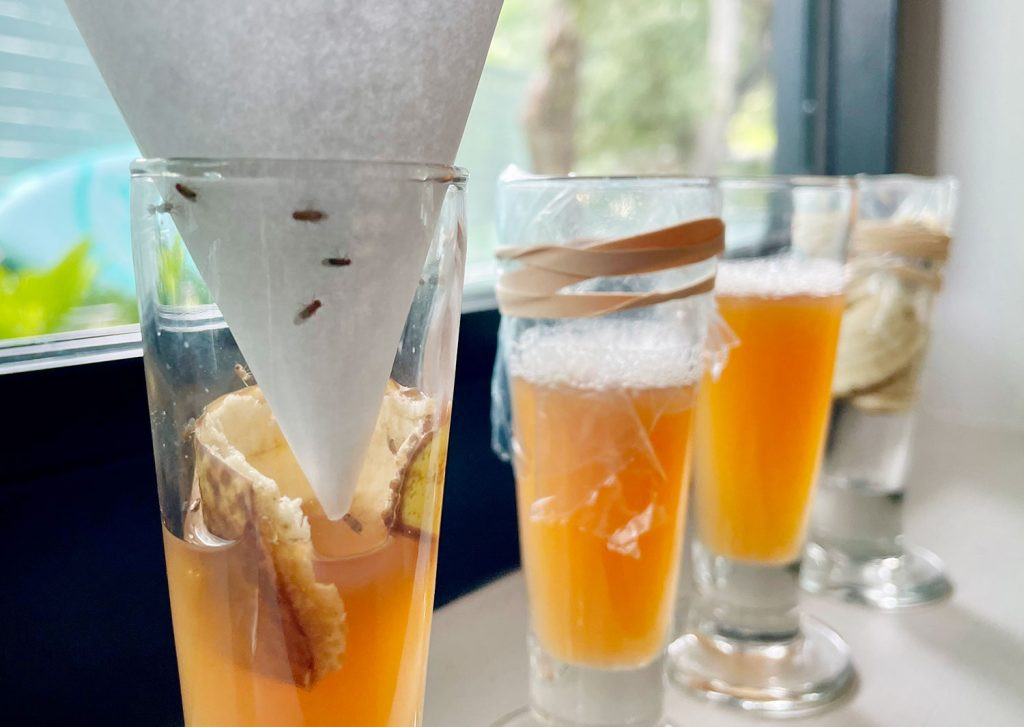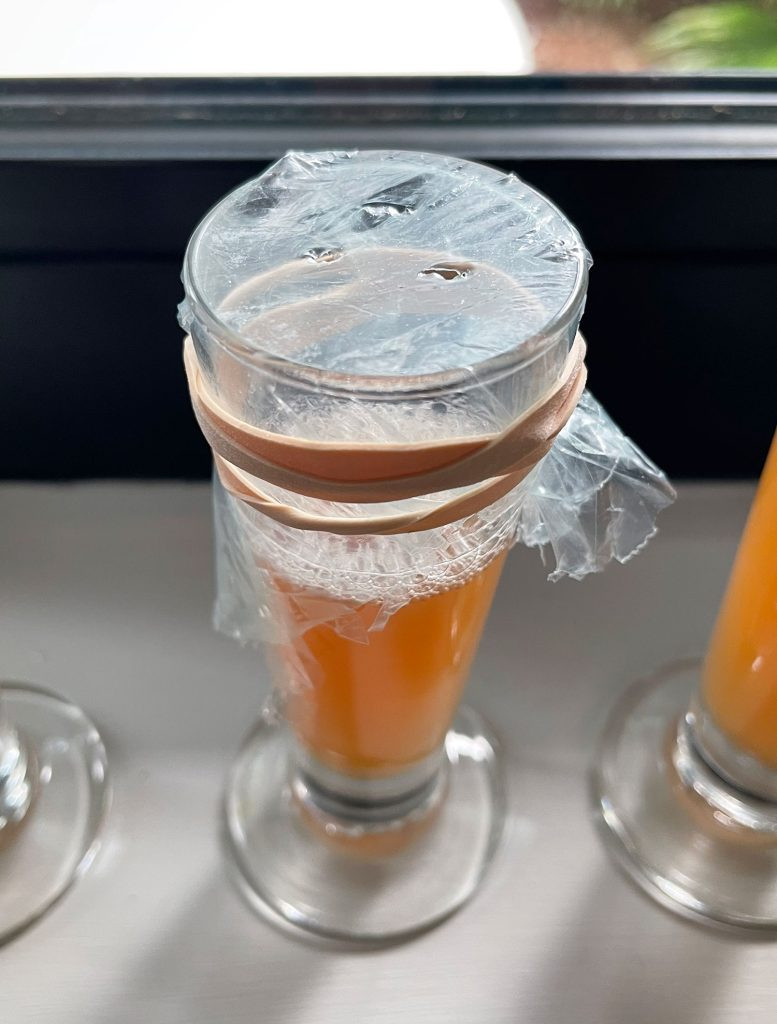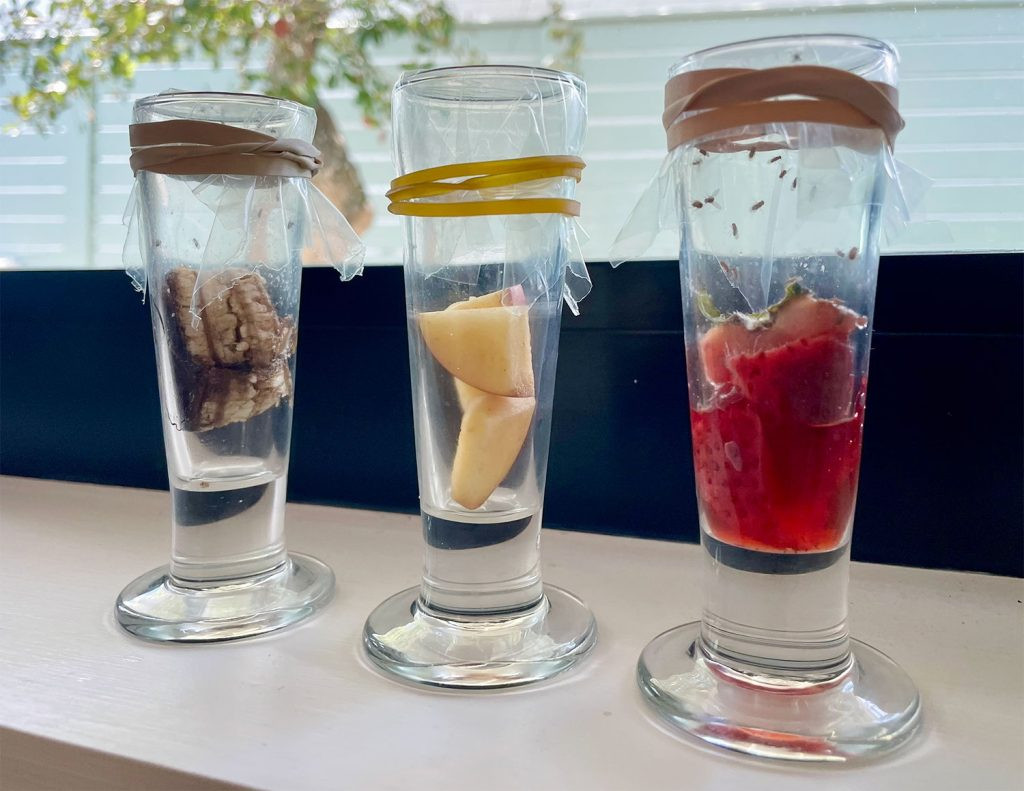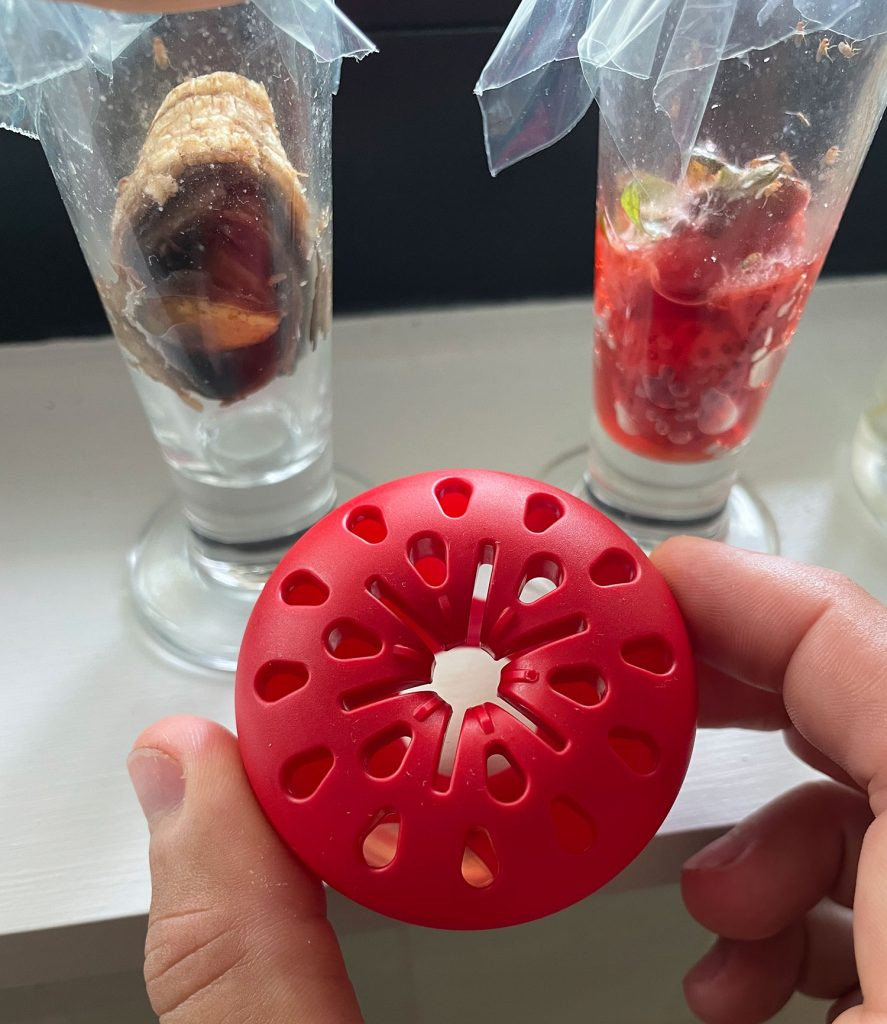Are you battling a swarm of pesky kitchen flies? These unwelcome guests, often fruit flies, can quickly turn a pleasant cooking space into an annoying battleground, but flyermedia.net can provide solutions. Discover the best methods for eliminating these pests and keeping your kitchen a fly-free zone. Implement proactive strategies by understanding the nuances of fruit fly behavior, sanitation practices, and effective trapping methods to ensure a consistently clean and pleasant environment.
1. What Exactly Are Kitchen Flies (Fruit Flies)?
Kitchen flies, most commonly fruit flies, are small flying insects attracted to fermenting or sugary substances. They are more than just a nuisance; understanding their biology and behavior is crucial for effective control.
- Appearance: Fruit flies are typically small, about 1/8 inch long, and have red eyes. Their bodies are usually tan or brownish.
- Life Cycle: According to research from the University of California, Davis, female fruit flies can lay hundreds of eggs near fermenting substances.
- Attraction: They are drawn to ripe, rotting, or fermenting fruits and vegetables, as well as sugary spills, open beverage containers, and damp areas.
- Common Misidentification: Fruit flies are often mistaken for drain flies or fungus gnats, but knowing the difference helps in targeting the correct pest control method.
2. How To Identify The Type Of Kitchen Fly?
Correctly identifying the type of fly is crucial for choosing the most effective elimination strategy. Here’s how to distinguish between common kitchen flies:
| Fly Type | Appearance | Common Location | Breeding Source |
|---|---|---|---|
| Fruit Flies | Small, tan or brownish, red eyes. | Near ripe or rotting fruits and vegetables. | Fermenting fruits, spills, drains. |
| Drain Flies | Small, fuzzy, moth-like appearance. | Near sinks, drains, and sewers. | Organic matter buildup in drains. |
| Fungus Gnats | Small, dark, mosquito-like appearance. | Near houseplants and damp soil. | Moist soil, decaying plant matter. |
| House Flies | Larger, grayish, with four dark stripes on the thorax. | Anywhere, especially near garbage and food. | Decaying organic matter, garbage. |
| Phorid Flies | Small, brownish, with a characteristic jerky flight pattern. | Near drains, garbage disposals, and decaying matter. | Decaying organic matter in drains, garbage disposals, or soil. |
 Fruit Flies Vs. Fungus Gnats Vs. Drain Flies
Fruit Flies Vs. Fungus Gnats Vs. Drain Flies
Fruit flies trapped in a DIY funnel trap, effectively demonstrating their attraction to the bait inside.
3. Why Are Kitchen Flies (Fruit Flies) Attracted To Your Kitchen?
Understanding why fruit flies are drawn to your kitchen is the first step in preventing and eliminating them. Several factors can make your kitchen an attractive breeding ground:
- Ripe or Rotting Produce: Fruit flies are highly attracted to the sugars in ripe or rotting fruits and vegetables.
- Sugary Spills and Residue: Spilled juice, soda, or other sugary liquids can attract fruit flies.
- Open Garbage Cans: Garbage cans, especially those containing food waste, provide an ideal breeding environment for fruit flies.
- Dirty Drains: Drains can accumulate organic matter that serves as a food source for fruit flies.
- Unclean Countertops and Surfaces: Sticky or unclean surfaces with food residue can attract fruit flies.
- Open Wine or Beer Bottles: Fruit flies are drawn to the fermentation process and can be attracted to open bottles of wine or beer.
4. How To Get Rid Of Kitchen Flies (Fruit Flies) With DIY Traps?
Creating your own fruit fly traps can be a cost-effective and environmentally friendly way to manage infestations. Here are several effective DIY trap methods:
4.1. How to make Funnel Trap to get rid of kitchen flies?
A funnel trap is a simple and effective way to capture fruit flies. The narrow opening makes it easy for flies to enter but difficult to exit.
- Materials:
- A small jar or container
- Apple cider vinegar or wine
- Paper or plastic funnel
- Tape
- Instructions:
- Pour a small amount of apple cider vinegar or wine into the jar.
- Insert the funnel into the jar’s opening, ensuring the tip doesn’t touch the liquid.
- Secure the funnel with tape to prevent flies from escaping.
- Place the trap in areas where fruit flies are most active.
4.2. How Effective Is A Plastic Wrap Trap At Eliminating Kitchen Flies?
A plastic wrap trap works by attracting fruit flies to a sweet scent and then trapping them under the plastic.
- Materials:
- A jar or cup
- Apple cider vinegar or mashed fruit
- Plastic wrap
- Rubber band
- Toothpick
- Instructions:
- Fill the jar with apple cider vinegar or mashed fruit.
- Cover the jar tightly with plastic wrap, securing it with a rubber band.
- Poke small holes in the plastic wrap with a toothpick.
- Place the trap in infested areas.
 DIY Fruit Fly Trap With Apple Cider Vinegar And Plastic
DIY Fruit Fly Trap With Apple Cider Vinegar And Plastic
A homemade fruit fly trap using apple cider vinegar and plastic wrap effectively captures fruit flies.
4.3. How To Use Dish Soap Trap?
The dish soap trap disrupts the surface tension of the liquid, causing fruit flies to drown.
- Materials:
- A small bowl
- Apple cider vinegar
- Dish soap
- Instructions:
- Fill the bowl with apple cider vinegar.
- Add a few drops of dish soap and gently mix.
- Place the bowl in areas with high fruit fly activity.
4.4. How Does Rotting Fruit Trap Work?
Using rotting fruit as bait can be highly effective since it mimics the natural food source that attracts fruit flies.
- Materials:
- A jar or container
- Rotting fruit (banana peel, apple core)
- Plastic wrap or paper funnel
- Instructions:
- Place the rotting fruit in the jar.
- Cover the jar with plastic wrap, securing it with a rubber band, and poke small holes, or use a paper funnel.
- Position the trap in areas where fruit flies are prevalent.
4.5. Comparing DIY Fruit Fly Traps
| Trap Type | Effectiveness | Ease of Setup | Cost | Additional Notes |
|---|---|---|---|---|
| Funnel Trap | High, especially with a narrow funnel. | Medium | Low | Best for capturing large numbers of flies. |
| Plastic Wrap Trap | Effective, easy to set up. | Easy | Low | Requires frequent emptying. |
| Dish Soap Trap | Moderate, good for continuous, passive trapping. | Easy | Very Low | Dish soap needs to be replenished occasionally. |
| Rotting Fruit Trap | Very high, if fruit is appealing to the flies. | Medium | Low | Requires replacing fruit regularly to avoid other odors. |
| Sticky Trap | High, once flies are lured to the surface. | Easy | Medium | Provides a visual indication of the infestation severity. |
5. What Baits Work Best for Kitchen Fly Traps?
Choosing the right bait can significantly increase the effectiveness of your fruit fly traps. Different baits attract fruit flies for various reasons, and experimenting can help you find the best option for your situation.
5.1. The Allure Of Apple Cider Vinegar (ACV)
Apple cider vinegar is a popular choice because its fermented scent closely mimics the odor of rotting fruit, which fruit flies find irresistible.
- Why It Works:
- The acetic acid in apple cider vinegar attracts fruit flies.
- It is less attractive to other insects, making it a targeted bait.
- How To Use It:
- Pour a small amount into your trap.
- Add a drop of dish soap to break the surface tension and trap the flies.
5.2. The Sweetness Of Wine And Beer
The sugars and fermentation byproducts in wine and beer also make them effective baits for fruit flies.
- Why It Works:
- The alcohol and sugars mimic fermenting fruit.
- Even leftover or stale beer and wine can be effective.
- How To Use It:
- Pour a small amount into your trap.
- No need to add soap, as the liquid itself is sufficient to trap the flies.
5.3. The Power Of Overripe Fruit
Using overripe fruit directly appeals to the fruit flies’ natural attraction to decaying organic matter.
- Why It Works:
- The strong scent of decaying fruit is highly attractive.
- It mimics their natural breeding environment.
- How To Use It:
- Place a piece of overripe fruit in your trap.
- Ensure the fruit is contained so it doesn’t attract other pests.
5.4. The Unexpected Appeal Of Strawberry
Strawberries, especially when slightly overripe, can be particularly effective due to their intense fruity scent.
- Why It Works:
- Strawberries have a strong, sweet aroma that attracts fruit flies.
- As they rot, they release even more enticing compounds.
- How To Use It:
- Place a few slices of strawberry in your trap.
- Monitor and replace as needed to maintain its effectiveness.
5.5. Enhancing Bait Effectiveness
To maximize the effectiveness of your chosen bait, consider these tips:
- Combination: Combine baits, such as adding a piece of fruit to apple cider vinegar.
- Freshness: Refresh the bait regularly, as its effectiveness diminishes over time.
- Location: Place traps near the source of the infestation for the best results.
- Quantity: Use multiple traps in different areas to cover a wider range.
 Fruit Fly Traps With Different Rotten Fruit Baits
Fruit Fly Traps With Different Rotten Fruit Baits
Fruit fly traps with different baits, including banana peel, apple slices, and strawberry, to test which is most effective.
6. Are Store-Bought Fruit Fly Traps Effective?
If DIY traps aren’t your preference, several commercial fruit fly traps are available. These traps are designed for ease of use and can be quite effective.
6.1. Types Of Store-Bought Traps
- Pre-baited Traps: These traps come with a specially formulated attractant.
- Sticky Traps: These traps use a sticky surface to capture flies.
- Electronic Traps: These traps use UV light to attract and then electrocute the flies.
6.2. Pros And Cons Of Store-Bought Traps
| Feature | Pros | Cons |
|---|---|---|
| Effectiveness | Often very effective, especially pre-baited traps. | Can be less effective if the attractant isn’t appealing to the flies. |
| Convenience | Easy to set up and use. | Can be more expensive than DIY options. |
| Aesthetics | Some are designed to be discreet. | May not be as environmentally friendly as DIY traps. |
| Safety | Safe for use around children and pets when used as directed. | Electronic traps may pose a risk if not used properly. |
6.3. How To Use Store-Bought Traps Effectively
- Read Instructions: Follow the manufacturer’s instructions for optimal use.
- Placement: Place traps near fruit fly hotspots.
- Maintenance: Replace traps or refill bait as needed.
- Monitoring: Monitor trap effectiveness and adjust placement or type as necessary.
 Terro Fruit Fly Apple Trap With No Fruit Flies In It
Terro Fruit Fly Apple Trap With No Fruit Flies In It
A store-bought Terro fruit fly trap placed next to DIY traps for comparison, showcasing its design and placement.
7. How To Prevent Kitchen Flies In The First Place?
Prevention is always better than cure. Implementing these strategies can help keep your kitchen fruit fly-free.
- Cleanliness: Regularly clean kitchen surfaces to remove food residue and spills.
- Proper Food Storage: Store fruits and vegetables in the refrigerator whenever possible.
- Garbage Management: Empty garbage cans frequently and keep them tightly sealed.
- Drain Maintenance: Clean drains regularly to prevent organic matter buildup.
- Inspect Produce: Check fruits and vegetables for signs of ripeness or decay when bringing them home.
- Seal Cracks and Openings: Seal any cracks or openings in your kitchen to prevent entry.
7.1. Maintaining A Clean Kitchen Environment
Regular cleaning is essential for preventing fruit flies. Focus on these key areas:
- Countertops: Wipe down countertops daily to remove spills and food residue.
- Sinks: Clean sinks and faucets regularly to prevent buildup.
- Floors: Sweep and mop floors to remove food particles.
- Appliances: Clean appliances such as toasters and blenders after each use.
7.2. Managing Fruit And Vegetable Storage
Proper storage of fruits and vegetables can significantly reduce the attraction for fruit flies.
- Refrigeration: Store fruits and vegetables in the refrigerator to slow down ripening and prevent fruit flies.
- Sealed Containers: Use sealed containers for fruits and vegetables stored at room temperature.
- Regular Inspection: Regularly inspect fruits and vegetables for signs of decay and discard promptly.
7.3. Effective Garbage Disposal Techniques
Proper garbage disposal is critical to prevent fruit flies from breeding in your kitchen.
- Frequent Emptying: Empty garbage cans frequently, especially after disposing of food waste.
- Sealed Bins: Use garbage cans with tight-fitting lids to contain odors and prevent access.
- Cleaning: Regularly clean garbage cans to remove residue and odors.
- Composting: Consider composting food scraps to reduce the amount of waste in your garbage.
7.4. Keeping Drains Clean And Clear
Drains can be a breeding ground for fruit flies due to the accumulation of organic matter.
- Regular Flushing: Flush drains regularly with hot water to clear buildup.
- Baking Soda and Vinegar: Use a mixture of baking soda and vinegar to clean drains.
- Drain Cleaners: Use enzymatic drain cleaners to break down organic matter.
- Physical Cleaning: Use a drain brush to physically remove buildup.
8. What Role Does Humidity Play In Kitchen Fly Infestations?
Humidity can significantly impact fruit fly infestations, as it affects their breeding and survival rates.
8.1. How Humidity Affects Fruit Flies
- Breeding: High humidity levels create an ideal environment for fruit fly larvae to thrive.
- Survival: Fruit flies require moisture to survive; dry conditions can dehydrate and kill them.
- Food Sources: Humidity can accelerate the decay of fruits and vegetables, increasing the attraction for fruit flies.
8.2. Controlling Humidity To Prevent Infestations
- Ventilation: Ensure good ventilation in your kitchen to reduce humidity levels.
- Dehumidifiers: Use dehumidifiers to lower humidity in particularly damp areas.
- Leak Repair: Fix any leaks promptly to prevent moisture buildup.
- Proper Storage: Store produce in well-ventilated areas or in the refrigerator to reduce moisture.
9. How Do Seasonal Changes Impact Kitchen Fly Activity?
Seasonal changes can influence fruit fly activity, with certain times of the year being more prone to infestations.
9.1. Fruit Fly Activity By Season
- Summer: Warm temperatures and ripe fruits make summer peak season for fruit flies.
- Fall: Harvest season continues to provide ample food sources.
- Winter: Indoor heating can create a favorable environment for fruit flies to survive.
- Spring: As temperatures rise, fruit fly populations can rebound quickly.
9.2. Adjusting Prevention Strategies Seasonally
- Summer: Increase cleaning efforts and monitor produce closely.
- Fall: Continue monitoring and promptly dispose of fallen fruit in gardens.
- Winter: Ensure proper ventilation and moisture control indoors.
- Spring: Start prevention efforts early to minimize population growth.
10. How Can Flyermedia.Net Help You With Aviation Career and Education?
While managing kitchen flies is essential for a clean home, flyermedia.net offers valuable resources for those interested in aviation careers and education.
- Information Hub: Flyermedia.net is a comprehensive resource for aspiring pilots, aviation enthusiasts, and industry professionals.
- Educational Resources: Access detailed information about flight schools, aviation regulations, and career paths.
- Career Opportunities: Explore job listings, industry news, and expert advice on advancing your aviation career.
Are you ready to take off towards your aviation dreams? Visit flyermedia.net today to explore flight schools, read the latest aviation news, and discover exciting career opportunities in the USA. Address: 600 S Clyde Morris Blvd, Daytona Beach, FL 32114, United States. Phone: +1 (386) 226-6000.
Frequently Asked Questions (FAQ) about How To Get Rid Of Kitchen Flies
1. What Are The Most Common Types Of Kitchen Flies?
The most common types of kitchen flies are fruit flies, drain flies, and fungus gnats.
2. Why Are Fruit Flies Attracted To My Kitchen?
Fruit flies are attracted to ripe or rotting fruits and vegetables, sugary spills, and damp areas.
3. How Can I Identify A Fruit Fly Infestation?
You can identify a fruit fly infestation by seeing small flies hovering around fruits, garbage cans, or drains.
4. What Are Some Effective DIY Fruit Fly Traps?
Effective DIY fruit fly traps include apple cider vinegar traps, plastic wrap traps, and dish soap traps.
5. How Does An Apple Cider Vinegar Trap Work?
An apple cider vinegar trap works by attracting fruit flies with the scent of vinegar, which they cannot escape once inside.
6. Can Store-Bought Fruit Fly Traps Be Effective?
Yes, store-bought fruit fly traps can be effective, especially pre-baited traps or sticky traps.
7. How Can I Prevent Fruit Flies From Entering My Home?
You can prevent fruit flies by keeping your kitchen clean, storing produce properly, and managing garbage effectively.
8. How Often Should I Clean My Kitchen To Prevent Fruit Flies?
You should clean your kitchen daily to remove food residue and spills that attract fruit flies.
9. Are Fruit Flies Harmful To Humans?
Fruit flies are generally not harmful to humans, but they can be a nuisance and contaminate food.
10. What Role Does Humidity Play In Fruit Fly Infestations?
High humidity levels create an ideal environment for fruit fly larvae to thrive, exacerbating infestations.
